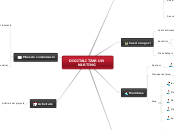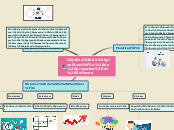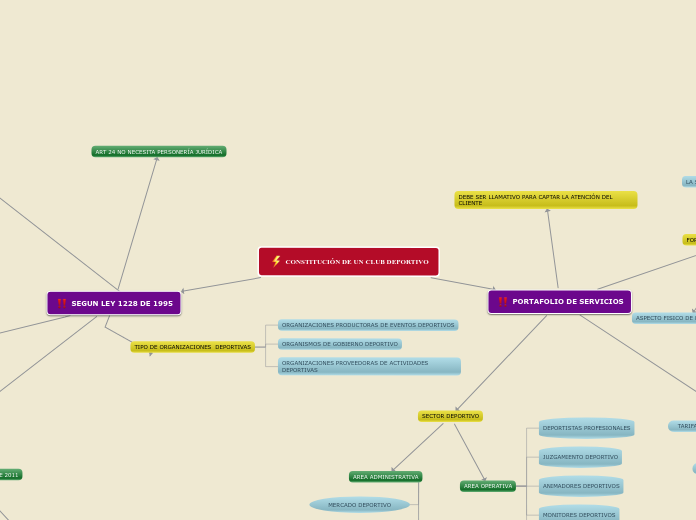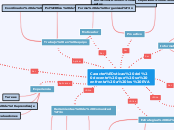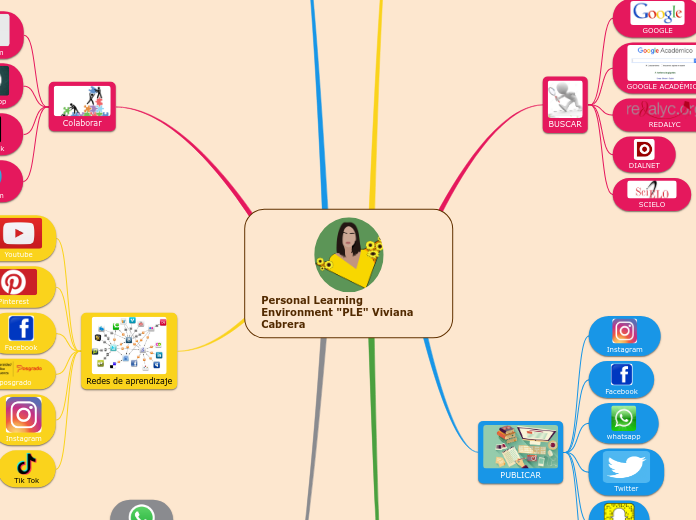DIGITALITZAR UN KARTING
Enter your project name
Begin by typing your project name into the Central Topic below, then press the Enter key or click the right-arrow button.
Activitats
Project activities and schedule
Although we are not planning a detailed schedule here, this map should include the major work elements so that they can be broken down into tasks later.
Anàlisis del projecte
Add a project activity
Type in a project activity. Examples include:
- Requirements collection and analysis
- Research and problem-solving
- Design and architecture
- Completing deliverables
- Acceptance testing and feedback
- Support and maintenance
1r trimestre del Grau
Add the timescale for this activity
When will this activity take place? Type an approximate date or a project stage.
Plans de comunicació
Communications plan
Communications are vital to your project, so that all stakeholders know what they need to know to play their part. A communications plan helps you to keep everyone informed.
Pla empresarial
Key communications events
Your communications plan should include a number of key events, with specific purposes and outcomes. You can choose from the suggestion that follow or add your own.
Revisió del projecte
Include a project review?
The project review meeting takes place once the project has been closed, and examines the processes that led to both success and failure in the project. The goal of the review meeting is to improve processes and techniques for the next time.
Click the icon to include a project review meeting:
2a Reunió
Include a close-out meeting?
The project close-out meeting confirms that the stakeholders are all satisfied with the outcomes of the project, and it can officially be accepted as complete.
Click the icon to include a close-out meeting:
Revisions
Include quality reviews?
If you have specific quality criteria to meet, or have a quality regime in your organisation, you may need to conduct periodic reviews to ensure that the project could pass an audit at any time.
Click the icon to include quality reviews:
RIsics i qüestions
Include risk and issue reviews?
You should periodically review project risks and issues, to ensure that new risks are not emerging, and that issues are not being left unaddressed.
Click the icon to include risk and issue reviews:
Revisió del progres
Include progress reviews?
If the project is large enough or if you are using an Agile methodology, you will need regular progress reviews with a consistent agenda.
Click the icon to include progress reviews:
Planificació
Include stage planning meetings?
If your project is large, or if you are using an Agile methodology, you may need regular planning meetings to schedule the project in stages.
Click the icon to include stage planning meetings:
Inici de la reunió
Include a kick-off meeting?
The project kick-off meeting ensures that the project team and key stakeholders all have the same goals, know what the main elements of the plan are, know what the processes and rules are, and know what part they will play.
Click the icon to include a kick-off meeting:
Eines de cooperació i col·laboració
Communication and collaboration tools
What communication and collaboration tools will you use? How will you issue bulletins, share documents and work collaboratively? Which tools will be suitable for your stakeholders?
Brainstorming
On-line
Add a communication tool
Add a communication / collaboration tool. Examples include:
- Physical meetings
- E-mail distribution lists
- Instant messaging and virtual meetings
- Local or cloud-based file sharing
- On-line project management tools
- On-line discussion boards
- Collaborative authoring tools
Gestió de requisits
Requirements Management
Requirements often make or break projects. If the requirements are not well known in advance, the way that you handle this situation will have a significant impact.
Knowing the requirements is important, but it is more important to be in control of the requirements, and to know what is excluded as well.
Què aprendrem?
Exclusions
For clarity, you should state any known exclusions that are definitely not part of the project, especially if there is a chance that someone might reasonably assume they are included.
Molta més experiència
Add an exclusion
Specify an exclusion from your project. Examples are
- Major changes in scope or specification
- On-site support
- Troubleshooting related systems
- Managing other subcontractors
- End-user training
- Replacing consumables
Ho sabem?
Known requirements
List the major known requirements for your project. If there are a lot, then you might choose to put these in a separate map. You can always come back and add more later. The important thing is that the requirements are gathered in one place and are roughly classified. Requirements can include:
- Legal compliances, e.g. Health & Safety law
- Compliance with standards
- Standard methodologies, e.g. Agile
- Compatibility with other systems or processes
- Physical specifications
- Functional specifications
- Performance specifications
- Quality specifications
- Use cases
Requirement
Add a requirement
Add a requirement in the topic text. Requirements should be specific enough to be tested. Prioritise it with MoSCoW grades by clicking on an icon:
- Must have - an essential requirement
- Should have - preferred, but a temporary workaround would be acceptable
- Could have - include if easy and all the Musts and Shoulds are complete
- Want to have - can be left for the future
Gestió
Requirements Management
How will you respond when requirements change? How will you keep track of changing requirements?
Llista a partir de la qual posarem els objectius
Add a requirements management technique
Add a technique or process to manage requirements. Techniques might include:
- Using a process for discovering requirements
- Maintaining a master list of requirements
- Writing testable and measurable requirements
- Establishing a formal process for agreeing changes to the requirements
- Verifying designs against requirements
Nivell de requisits
Indicate your confidence level
How confident do you feel about the requirements specification for this project? Can you start designing now, or will you need to spend time defining the requirements?
Click the icon that represents your confidence level:
Press Enter or click the right-arrow to continue.
Membres
Project Stakeholders
A 'Stakeholder' is anyone who might be affected by the project or its outcomes. Some stakeholders are clear, for example the customer and users. But sometimes there are hidden stakeholders, such as people who share the resources that the project will also use. You will need a list of stakeholders for your communication plans.
Grup
Customers
Who are the people in the customer's organisation who are important to the project?
Sergi Lopez
Marc miravet
David Moros
Marc cabrera
Jordi Garcia
Add a customer representative
Add a customer representative. These might include people who:
- Define and agree requirements
- Monitor progress
- Resolve issues
- Accept deliverables
Manager del grup
Customer account manager
Who takes care of the customer, and represents their interests with your team?
El grup sencer
Add an account manager
Add a customer account manager.
Sponsor
Project sponsors
Project sponsors are the senior members of your organisation who are backing (or will need to be persuaded to back) your project. They provide the authority for the project.
Tecnocampus
Add a project sponsor
Add a name and press Enter.
Cas de negoci
The Business Case
The Business Case justifies the investment in the project. If your project is already approved, then you can skip over this section and delete it later. But if you need buy-in for your project, then you may need to make a simple business case.
Pla estratègic
Strategic 'fit'
How well does this project fit your strategy?
Is it 'strategic'?
Does it help you along the road towards strategic goals, either for your team, department or company?
Donar-se a conèixer a través de les noves tecnologies
Add a strategic reason
Add a strategic reason for this project.
Beneficis
Key benefits
What are the key benefits to your organisation in taking this project forward?
Donar-se a conèixer
Tindran molt més avantatge competitiu
Add a key benefit
Type in a key benefit from this project. Examples include:
- Creating new opportunities
- Gaining a competitive advantage
- Solving a key problem
- Developing new knowledge
Costs estimats
Estimated costs
Estimated costs will help to determine the level of authorisation required, the cost/benefit ratio, and the opportunity costs of the project.
Gratuït
Add an estimated cost
Type in the name of a cost and the estimated amount. Typical costs include:
- Internal staff costs
- Contracted labour costs
- Outside services
- Capital costs and materials
- Opportunity costs - what else will not be done
Declaració del treball
The Statement of Work
The first thing to write is the Statement of Work. This gives a high-level overview of the major items that the project should deliver.
Assumptions
Project assumptions
What assumptions are you making in order to deliver this project successfully?
What is outside your control, or is on your list to'deal with later'?
Hem de portar el treball al dia
El grup ha de treballar conjuntament
Add an assumption
Type an assumption into the topic text. Examples include:
- Resources will be available
- Technology will work reliably
- Materials costs will stay the same
- Another project will finish on time
Restriccions
Project constraints
A constraint is a condition that must be met. Constraints set non-negotiable limits and are often restrictive.
Ha de ser gratuït
Treballs antics, sense digitaitzar
Add a Constraint
Type in a project constraint, or just press Enter to skip. Examples of constraints include:
- Production line 1 is not available
- Design resources must be released by September
- Salary budget cannot be increased
Recursos
Project resources
What are the key resources that this project will need?
A partir de la investigació grupal
Add a project resource
Add a key resource that your project will need. Examples include:
- People
- Equipment
- Materials
- Services and expertise
- Short term finance or capital investment
Fites
Milestones
A project milestone is an event that shows progress along the path towards completion. Milestones usually have deadline dates.
Diagrama de PERTT
Add a project milestone
Type in the name of a milestone for your project. Examples include:
- A strategic decision
- Signing an agreement
- A key meeting
- Acceptance of a deliverable
Dia lliurament
Add a milestone date
Enter an approximate target date for this milestone.
You can return later to customise the task information in this Mindomo map and start using its project management features.
Què lliurarem?
Deliverables
A project deliverable is evidence of real progress. It is something that can be handed to your customers or users.
Organigrama de grup
Document on hi haurà tot el treball escrit
Add a project deliverable
Type a project deliverable into the topic text below, and press Enter. When you are finished, press Enter again. Examples of project deliverables include:
- A key document or agreement
- Some equipment or working software
- An event, such as a demonstration or training
